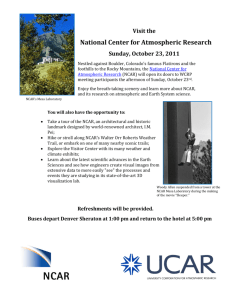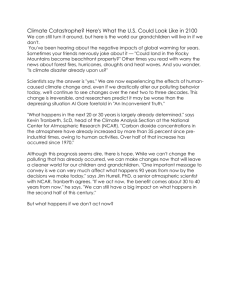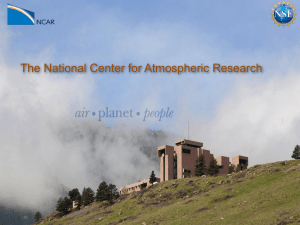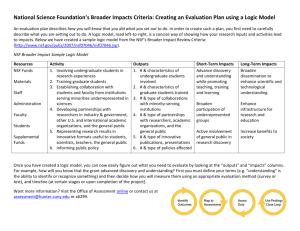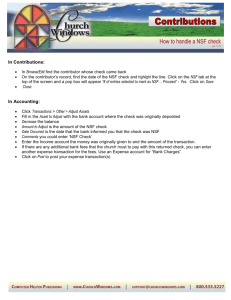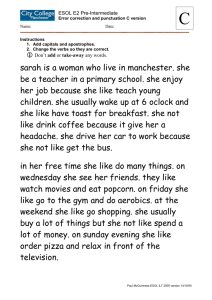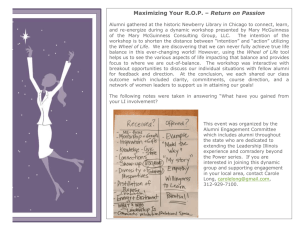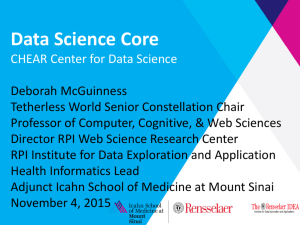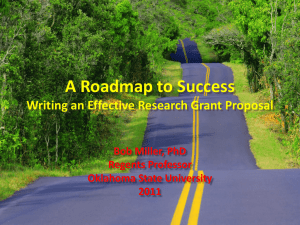The Semantic Web - Deborah McGuinness, Stanford University
advertisement
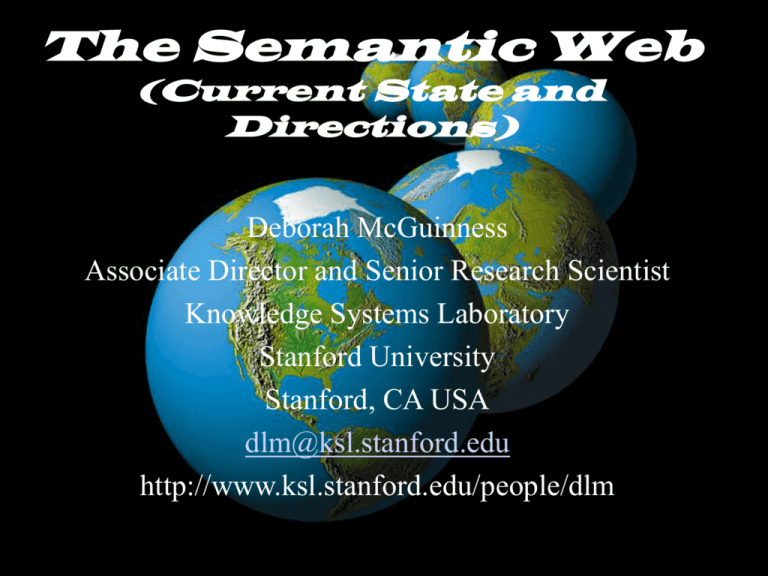
The Semantic Web (Current State and Directions) Deborah McGuinness Associate Director and Senior Research Scientist Knowledge Systems Laboratory Stanford University Stanford, CA USA dlm@ksl.stanford.edu http://www.ksl.stanford.edu/people/dlm McGuinness NSF/NCAR October 30, 2002 Outline • Web: today and tomorrow – The key to tomorrow’s web is semantics • Semantics on the web requires: – Language for encoding meaning (XML, RDF/S -> DAML+OIL, OWL) – Ontologies (Term descriptions and their interrelationships) – Tools • Conclusion and Pointers McGuinness NSF/NCAR October 30, 2002 Today: Rich Information Source for Human Manipulation/Interpretation Human Human Human McGuinness NSF/NCAR October 30, 2002 Human “I know what was input” The web knows what text was input (and is great at information dissemination) but does little interpretation, manipulation, integration, and action. Analogous to a new assistant who is thorough yet lacks common sense, context, adaptability, and the ability to interpret for you McGuinness NSF/NCAR October 30, 2002 Tomorrow: Rich Information Source for Agent Manipulation/Interpretation Human Agent Agent McGuinness NSF/NCAR October 30, 2002 “I know what was meant” • • • • • Understand term meaning and user background Interoperable (can translate between applications) Programmable (thus agent operational) Explainable (thus maintains context and can adapt) Capable of filtering (thus limiting display and human intervention requirements) • Capable of executing services McGuinness NSF/NCAR October 30, 2002 Layer Cake Foundation McGuinness NSF/NCAR October 30, 2002 Semantic Markup In languages such as OWL, DAML+OIL (http://www.w3.org/2001/sw/WebOnt/, http://www.daml.org), we capture • Background info • User modeling info for • Annotating web pages (man/automatically) • Annotating services Ontologies DAML/OWLenabled web pages thereby limiting needs for human disambiguation input, human interpretation, multiple answer display, translation assistance, agent assistance, adaptivity support, etc.) McGuinness NSF/NCAR October 30, 2002 DAML/OWL Language •Extends vocabulary of XML and RDF/S •Rich ontology representation language •Language features chosen for efficient implementations Frame Systems Web Languages RDF/S XML DAML-ONT DAML+OIL OWL OIL Formal Foundations Description Logics FACT, CLASSIC, DLP, … McGuinness NSF/NCAR October 30, 2002 W3C WEBONT catches on…. • Includes over 50 members from over 30 international organizations. – Industry including: • Large companies such as Daimler Chrysler, EDS, Fujitsu, HP, IBM, Intel, Lucent, Motorola, Nokia, Philips Electronics, Sun, Unisys, … • Newer/smaller companies such as IVIS Group, Network Inference, Stilo Technology, Unicorn Solutions, … – Government and Not-For-Profits: • Defense Information Systems Agency, Interoperability Technology Association for Information Processing, Japan (INTAP) , Intelink Mgt Office, Mitre, • ARDA, CIA, DARPA, DIA, NCI, NIH, NIST, NSF, … – Universities and Research Centers: • Stanford University, University of Bristol, University of Maryland, University of Southamptom, … • DFKI (German Research Center for Artificial Intelligence), Forschungszentrum Informatik – Invited Experts • Well-known academics from non-W3C members McGuinness NSF/NCAR October 30, 2002 OWL Lite Features • • • • • • RDF Schema Features – Class, rdfs:subClassOf , Individual – rdf:Property, rdfs:subPropertyOf – rdfs:domain , rdfs:range Equality and Inequality – sameClassAs , samePropertyAs , sameIndividualAs – differentIndividualFrom Restricted Cardinality – minCardinality, maxCardinality (restricted to 0 or 1) – cardinality (restricted to 0 or 1) Property Characteristics – inverseOf , TransitiveProperty , SymmetricProperty – FunctionalProperty(unique) , InverseFunctionalProperty – allValuesFrom, someValuesFrom (universal and existential local range restrictions) Datatypes – Following the decisions of RDF Core. Header Information – imports , Dublin Core Metadata , versionInfo McGuinness NSF/NCAR October 30, 2002 OWL Features • Class Axioms – – – – • oneOf (enumerated classes) disjointWith sameClassAs applied to class expressions rdfs:subClassOf applied to class expressions Boolean Combinations of Class Expressions – unionOf – intersectionOf – complementOf • Arbitrary Cardinality – minCardinality – maxCardinality – cardinality • Filler Information – hasValue Descriptions can include specific value information McGuinness NSF/NCAR October 30, 2002 OWL Lite and OWL • Feature Synopsis: http://www.w3.org/TR/owl-features/ • Guide: http://www.w3.org/TR/owl-features/ • Reference Description: http://www.w3.org/TR/owl-ref/ • Abstract Syntax: http://www.w3.org/TR/owl-absyn/ McGuinness NSF/NCAR October 30, 2002 Do I have to build the ontologies myself? Maybe not….Ontologies (suitable for reuse) are exploding • Upper Level Ontologies – UNSPSC, SUO, OpenCyc, OpenDirectory, TAP, … • Specialized Ontologies – UMLS, SNOMED, GO, CIA World Fact book, DAML-S…, even vc’s – Vulcan,… • Ontology Libraries – http://www.daml.org/ontologies/ – http://www.ksl.stanford.edu/ontolingua • “Advisory” bodies – Semantic Web Science Foundation, NIST, Ontology.org, … McGuinness NSF/NCAR October 30, 2002 Ontologies in most areas … including the environment Quick web search yielded: • Semantic Web for Earth and Environmental Terminology –JPL. http://oceanesip.jpl.nasa.gov/sweet • National Institute for environmental eScience – Cambridge http://www.niees.ac.uk/ • Gene Ontology – “dynamic controlled vocabulary that can be applied to all organisms” http://www.geneontology.org/ • Design and Creation of Ontologies for Environmental Information Retrieval- Telecordia - http://sern.ucalgary.ca/KSI/KAW/KAW99/papers/Kashyap1/kashyap.pdf • Ontologies of environmental applications for a digital library of scientific collections - http://dlforum.external.forth.gr:8080/papers/EnviroInfo.pdf • Waste water ontology – decision support for wastewater treatment processes - http://citeseer.nj.nec.com/ceccaroni00wawo.html • ... Many others … McGuinness NSF/NCAR October 30, 2002 Tools Tools developing: http://www.daml.org/tools/ Annotation Browser Crawler Editor Graph Visualizer Transformation Validator Importer Inference Engine Ontology Translation Persistence Query Tools RDMS Mapping Report Generation Search Ontology Analyzer Ontology Editor Merging Many are in research labs, but companies emerging and lasting… Network Inference, Sandpiper, Ontoprise, AppliedSemantics, Sentius, …. McGuinness NSF/NCAR October 30, 2002 Conclusion/Discussion • The Semantic Web is in its infancy today but is ready for applications • Markup languages, ontologies, and some tools are ready for use • Specialized tools are buildable/usable today • Semantic web can be leveraged to support: (items from Tim, Margaret, Dan, David’s presentations): interoperability, modeling, synthesis, integrity checking, prediction, information dissemination, quick start to “poor man’s managed/curated data repositories”, foundation for “richer man’s repository, foundation for new communication mode, distributed collaboration, knowledge mgmt, knowledge from data, “democratizing information”, “build between”, … • Input welcome: if you need something from the semantic web community you don’t see, tell us McGuinness NSF/NCAR October 30, 2002 Some Pointers • Ontologies Come of Age Paper: http://www.ksl.stanford.edu/people/dlm/papers/ ontologies-come-of-age-abstract.html • OWL: http://www.w3.org/TR/owl-features/, http://www.w3.org/TR/owl-ref/ • DAML+OIL: http://www.daml.org/ , http://www.w3.org/TR/daml+oil-reference McGuinness NSF/NCAR October 30, 2002 Extras McGuinness NSF/NCAR October 30, 2002 What is an Ontology? Catalog/ ID Thesauri “narrower term” relation Terms/ glossary McGuinness Frames General Formal is-a (properties) Logical constraints Informal is-a Formal instance NSF/NCAR October 30, 2002 Disjointness, Value Inverse, partRestrs. of… Stated goals of Semantic Web • Define conventions for applications that exchange metadata on the Web • Enable vocabulary semantics to be defined by communities of expertise, not W3C or other standards bodies • Provide for the fine-grained mixing of diverse metadata • Making it cost-effective for people to effectively record their knowledge. • Ultimate goal - the design of enabling technologies to support machine facilitated global knowledge exchange McGuinness NSF/NCAR October 30, 2002 DARPA DAML Program • Began in August 2000 Kickoff meeting • 19 Research groups supported • Initial ontology language aims to extend XML, RDF/S, benefit from frames, benefit from principled KR systems like Description Logics • DAML-ONT released in Oct. 2000 • DAML+OIL released in March 2001 McGuinness NSF/NCAR October 30, 2002 DAML+OIL -> W3C • W3C Webont working group formed with DAML+OIL submission as starting point http://www.w3.org/Submission/2001/12/ • Web Ontology Working Group in the W3C Semantic Web Activity aimed at “extending the semantic reach of current XML and RDF meta-data efforts. “ McGuinness NSF/NCAR October 30, 2002 WEBONT cont. • Quarterly Face to Face meetings in – – – – Murray Hill: http://www.w3.org/2001/sw/WebOnt/ftf1.html Amsterdam: http://www.w3.org/2001/sw/WebOnt/ftf2.html Stanford: http://www.w3.org/2001/sw/WebOnt/ftf3.html Bristol: http://www.w3.org/2001/sw/WebOnt/ftf4 – Expected recommendation status at w3c meeting in march. • Interesting Documents: – DAML+OIL submission – full spec with reference description, walkthrough, FOL and model theoretic semantics, http://www.w3.org/TR/daml+oil-reference – Use Case and requirements document: http://www.w3.org/TR/webont-req/ McGuinness NSF/NCAR October 30, 2002 Contact Information dlm@ksl.stanford.edu www.ksl.stanford.edu/people/dlm McGuinness NSF/NCAR October 30, 2002 Some Observations… • Markup Languages are growing in acceptance and expressive power • User base, tool base, ontology base growing • Ontology-enhanced applications springing up (not just in ivory towers like FindUR, eCyc, …) McGuinness NSF/NCAR October 30, 2002 Simple Ontology-Enhanced Apps McGuinness NSF/NCAR October 30, 2002 McGuinness NSF/NCAR October 30, 2002
